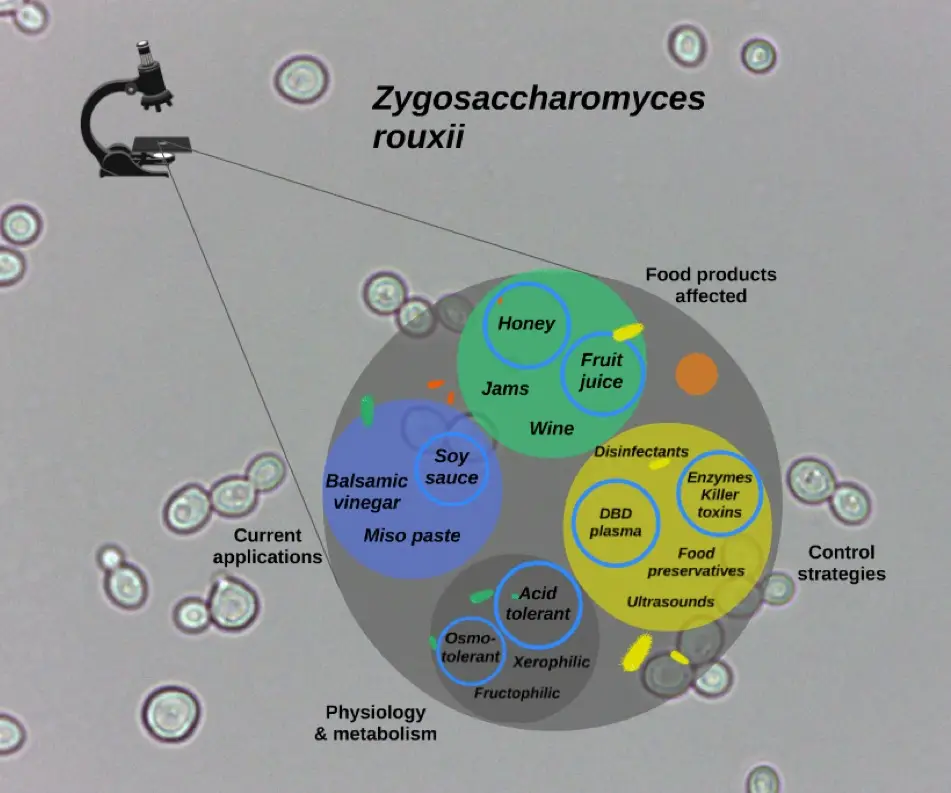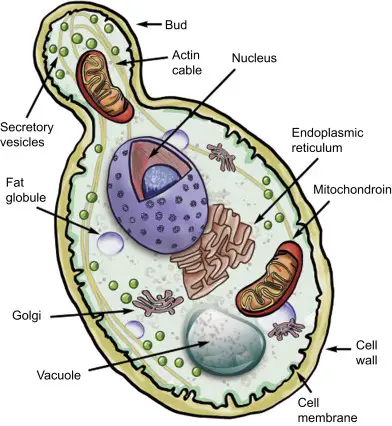This is a (slight edited) extract of a lengthly literature review written by a 3rd-year food science and technology student, Doreen Ting, at RMIT University in 2008 – I (Dr Philip Button) was her project facilitator. The overall literature review is excellent, and despite its age, at 14 years old now, it will still serve a purpose as a review of the fundamental elements of key food spoilage yeasts. On 5 January 2020, we published a blog article as part 1 in this series, giving an overview of the significance of yeasts in this context. We won’t label this and subsequent articles as parts, but shall provide links to them, and to a separate document which contains all the literature cited.
Introduction Yeast are of particular interest to food microbiologists due to the significant economical losses they cause to the food and beverage industry. There are several species, which are of particular concern including Zygosaccharomyces rouxii (Martorell et al., 2004; Steels et al., 1999) and Zygosaccharomyces bailii (Martorel et al., 2004; Vermeulan et al., 2008). These yeasts are characterised by their ability to survive, and indeed thrive, in normally hostile environments (Encyclopaedia of Food Microbiology 1999, p. 2359; Makdesi & Beuchat, 1996). These conditions include low pH, low water activity (aw), high levels of preservatives, and high osmotic pressure. Their ability to tolerate stress conditions has been, ad still remains, of major concern to the food industry.

Physiology and biochemistry of food spoilage yeasts
Yeast are unicellular fungi in which asexual reproduction occurs mainly through budding. According to Frazier & Westhoff (2005), although species of yeasts may differ considerably in their physiology, those of industrial importance have enough physiological characteristics in common to allow generalisation. This is inclusive of both beneficial and detrimental yeast species, bearing in mind regardless, both group of yeast may still have different physiological characteristics depending on their relationship to the food industry, which will later be understood in this review.
Most microorganisms grow best in environments with vast amounts of moisture. Yeast however prefers environment with high concentrations of solutes such as sugar or salt. Majority of bacteria do not possess the ability to grow in such conditions unlike yeast. Yeast grows in food with water activity level ranging from 0.88 to 0.94 (Frazier & Westhoff, 2005). However, one particular species has the ability to grow at a water activity level as low as 0.62 (Frazier & Westhoff, 2005; Martorell et al., 2004), which is Zygosaccharomyces.
In general, most yeast grow in the temperature range of between 25 °C to 30 °C, with some having heat tolerance of up to 75 °C (Thomas & Davenport, 1985). In addition, majority of yeast favours acidic conditions with a pH range of 3.0 – 7.0 (Fleet, 2006). Nevertheless, some generaare able to grow at a pH of as low as 2.5 (Steels et al., 1999). According to Flores et al. (2000), sugar is an excellent source of energy and carbon for all yeasts. Deak (2008) in being more specific stated that only a few sugars could by fermented by yeasts, which are mostly hexoses and oligosaccharides. The type of sugar most commonly utilised by all known yeast includes fructose (Boles & Hollenberg, 1997; Flores et al., 2000; Levya et al., 1999) and glucose (Boles & Hollenberg, 1997; Flores et al., 2000). In addition to hexoses and oligosaccharides, yeasts are also able to utilise several ‘non-conventional’ carbon sources including fatty acids (Trotter, 2001), pentoses (Flores et al., 2000) and alcohol (Frazier & Westhoff, 2005). The fermentation of sugar by yeast produces alcohol and carbon dioxide and has been the basis for the production of alcoholic beverages and leavened bakery products (Deak, 2008), which is beneficial to the food industry. However, this has also caused unfavourable effects to food, which will be further explained in the review.

As mentioned earlier, yeast has exceptional tolerance to stress environments. Extensive research has repeatedly shown resistance of some yeast to certain hurdles, which impart microbiological shelf-stability protection to processed foods. Increasing demand for foods with reduced amounts of chemical additives and less physical damages has increased the need for application of the “hurdle technology” concept in food preservation (Leistner 1995, cited in Palou et al. 1997). Leistner (2000) indicated that the concept of “hurdle technology” is the key to achieving success in food preservation. In this case, hurdles include the use of weak-acid preservatives, low pH, low aw, and high osmotic pressure in controlling the growth of yeast in food products.
The yeast genus Zygosaccharomyces is the most prominent food spoiler of all genera in the food industry, as three species (Zygosaccharomyces bailii, Zygosaccharomyces rouxii and Zygosaccharomyces bisporus) from this particular genus possess several intrinsic physiological resistance factors, which have caused them to survive in harsh environments, compared to other genera. In some cases, these yeasts are found to be innately resistant to common food preservatives, which includes acetic acid (Steels et al., 2000; Thomas & Davenport, 1985; Warth 1989), lactic acid, propionic acid (Warth 1986), benzoic acid (Cole et al., 1987; Macpherson et al., 2005; Makdesi & Beuchat, 1996; Warth, 1986), sorbic acid (Cole et al., 1987; Macpherson et al., 2005; Thomas & Davenport, 1985), sulphur dioxide (Cole et al., 1987) and ethanol (Encyclopaedia of Food Microbiology 1996, p. 2361) states that the organism utilises an inducible, active transport pump to counteract the toxic effects produced by undissociated preservative molecules (Hazan et al., 2004; Pampulha & Loureiro-Dias, 1989; Raso et al., 1998; Vermuelen et al., 2008) build-up inside individual cells. Exposure to preservatives is expected to cause membrane destabilisation, reduced adenosine triphosphate (ATP) production and oxidative damage to cell membranes (Hazan et al., 2004; Piper, 1999). However, due to the mechanism stated earlier, some of these species are able to resist weak-acid preservatives in food products.
The metabolism of this particular genus is also distinctive. In this case, Zygosaccharomyces metabolises fructose more rapidly than glucose compared to most yeast (Levya et al., 1999). In addition, the enhancement of resistance to preservatives was found caused by high sugar levels in food. As mentioned earlier, a pump is used to offset the toxic effects.
Links to related articles and to the reference list of literature cited in this and/or related articles.
Overall importance and general characteristics of food spoilage yeast Blog article published on 5 January 2020.

